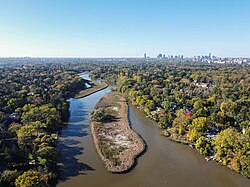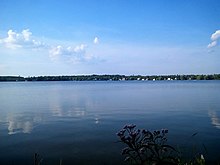| Credit River | |
|---|---|
 The Credit River in Port Credit | |
| Etymology | From Rivière au Crédit, used by French fur traders |
| Native name | Missinnihe |
| Location | |
| Country | Canada |
| Province | Ontario |
| Physical characteristics | |
| Source | Niagara Escarpment |
| • location | near Orangeville, Ontario and Caledon East, Ontario |
| • elevation | 400 m (1,300 ft) |
| Mouth | Lake Ontario |
• location | Port Credit |
• coordinates | 43°32′52″N 79°34′51″W / 43.54778°N 79.58083°W[1] |
• elevation | 74 m (243 ft)[2] |
| Length | 90 km (56 mi)[3] |
| Basin size | 1,000 km2 (390 sq mi)[3] |
| Discharge | |
| • location | Erindale, Mississauga[4] |
| • average | 8.12 m3/s (287 cu ft/s)[4] |
| • minimum | 0.085 m3/s (3.0 cu ft/s) |
| • maximum | 501 m3/s (17,700 cu ft/s) |
The Credit River is a river in southern Ontario, which flows from headwaters above the Niagara Escarpment near Orangeville and Caledon East to empty into Lake Ontario at Port Credit, Mississauga. It drains an area of approximately 1,000 square kilometres (390 sq mi). The total length of the river and its tributary streams is over 1,500 kilometres (930 mi).
Despite urbanization and associated problems with water quality on the lower section of this river, it provides spawning areas for Chinook salmon and rainbow trout. There is a fish ladder on the river at Streetsville. Much of the river can still be travelled by canoe or kayak. The headwaters of the Credit River is home to a native self-sustaining brook trout population and an introduced brown trout population.
Credit Valley Conservation, the local watershed management conservation authority, operates several Conservation Areas including Belfountain, Island Lake, and Terra Cotta.


Forks of the Credit Provincial Park is located on the upper part of the river between Brampton and Orangeville, and is near the Bruce Trail.
Communities in the river's watershed include the following:
- ^ "Credit River". Geographical Names Data Base. Natural Resources Canada.
- ^ Google Earth elevation for source coordinates
- ^ a b "Credit River Watershed". Credit Valley Conservation. Archived from the original on 9 August 2010. Retrieved 31 October 2010.
- ^ a b Station 02HB002 (Credit River at Erindale), Archived Hydrometric Data Archived 2007-12-31 at the Wayback Machine, Water Survey of Canada
